Exhibit - Snelling Room Artwork
The Richard and Barbara Snelling Room of the Vermont History Museum houses a collection of portraits and landscape paintings reflecting the 18th and 19th century history of the Capital Region. Artwork is hung in a traditional, 19th-century, salon style reminiscent of the early years of the Vermont Historical Society.


Abraham Lincoln
Interpretative Labels
Label
Abraham Lincoln, c. 1865
Unknown Artist
Vermont
Oil on canvas
Gift of Robert and Dona Bradish, #2019.9
After Abraham Lincoln's death, images of the president became very popular in households and public buildings. This portrait, a copy of the famous Matthew Brady Gettysburg photograph, was commissioned by a family in Bellows Falls, Vermont.
Name/Title
Abraham Lincoln
Type of Painting
Lexicon
Description
Portrait showing a man wearing a black, three-piece suit, a white shirt with a fall-collar, and a black tie or cravat. He has dark hair and a short beard following his jawline.
Acquisition
Accession
2019.9
Artwork Details
Medium
Oil
Subject Person
Lincoln, Abraham (1809-1865)
Subject
Abraham Lincoln
Made/Created
Time Period
19th Century
Date made
circa 1865
Entry/Object ID
2019.9.1
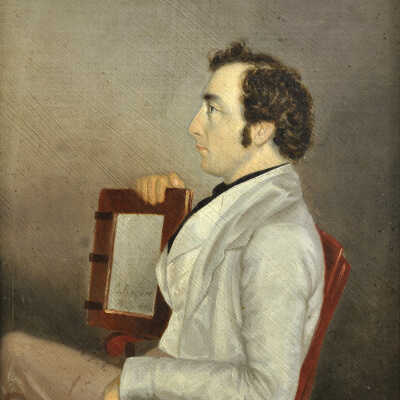
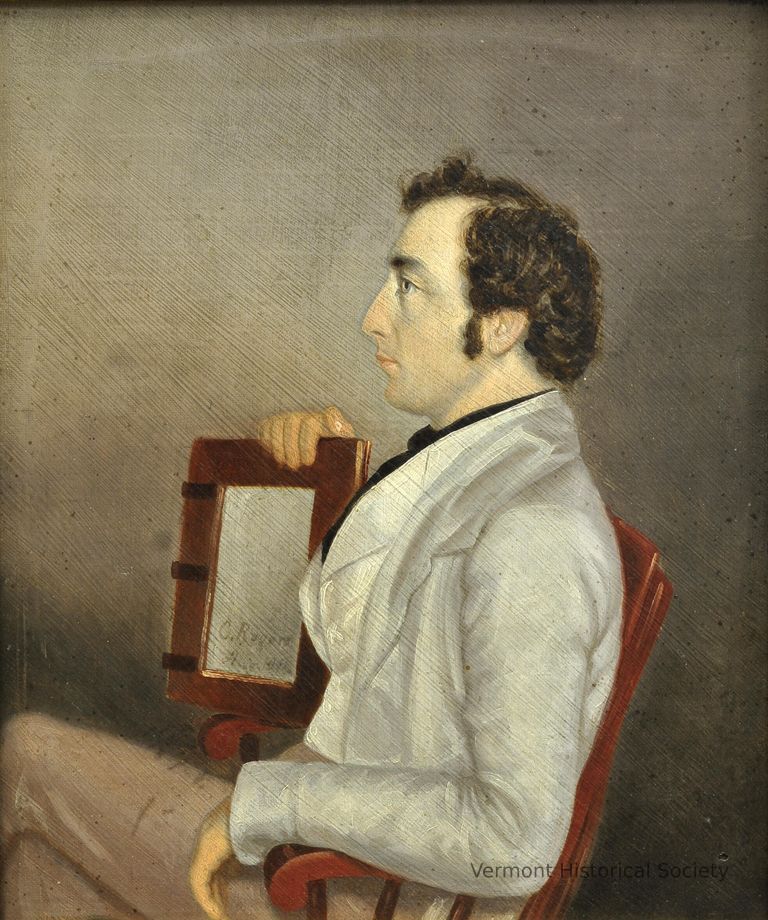
Ammi B. Young
Interpretative Labels
Label
Ammi B. Young, 1846
C. Rogers
Montpelier, Vermont
Oil on canvas
Gift of Mrs. Margaret Ross Ferguson, 1971.53.1
Ammi Young (1800-1874) was the architect for the second Vermont State House. He went on to a successful career as an architect for the federal government during the 19th century. Among his other recognizable buildings are the Customs House in Boston and the Treasury Building in Washington, DC.
Name/Title
Ammi B. Young
Lexicon
Description
Portrait showing a man sitting in profile, holding a small painting. The man has curly, dark hair, and is wearing tan trousers, a white jacket, a white vest, and a black shirt. He holds a small painting on the arm of his red Windsor arm chair, but the painting is facing away from the viewer, showing the stretcher and the artist's signature on the back of the canvase ("C. Rogers Aug. 1846"). the stretcher itself is labeled with "No. 232 Young." His other arm is draped casually on the arm of the chair, and his legs are crossed at the knee.
Acquisition
Accession
1971.53
Relationships
Related Places
Place
Vermont State House
Building
Montpelier
City
Washington County
County
Vermont
State/Province
United States of America
Country
North America
Artwork Details
Medium
Oil
Subject Person
Young, Ammi Burnham (1798-1874)
Made/Created
Artist Information
Rogers, C.
Artist
Date made
Aug 1846
Dimensions
Entry/Object ID
1971.53.1
Context
Painted by C. Rogers in Montpelier in 1846, and shows Ammi B. Young, the architect of the State House.
Web Links and URLs
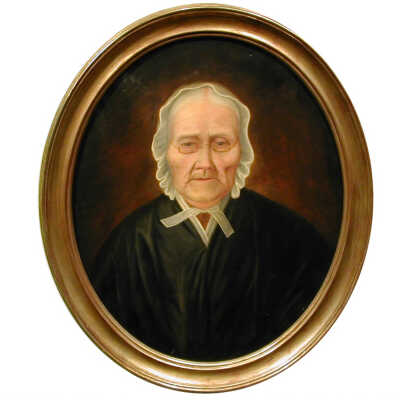

Anna Gray Child
Interpretative Labels
Label
Anna Gray Child, 1856
James Hope (1818-1892)
Castleton, VT
Oil on Canvas
Gift of Stephen C. Millett, jr., #A-114
Castleton Resident Alonzo Child commissioned James Hope to paint his parents and in-laws in 1856. His mother-in-law, Mary Wallis Goodrich, can be found in the Freedom and Unity Exhibit.
James Hope immigrated to Canada from Scotland with his father at a young age. At the age of 15, upon the death of his father, he walked to Vermont to start a new life. In addition to mechanical work, he studied painting at Castleton Seminary and set up a studio to produce portraits. After his Civil War service he increasingly produced landscapes, for which he is best known today.
Name/Title
Anna Gray Child
Lexicon
Description
Oval portrait showing an elderly woman in a white bonnet and black clothing. She is wearing gold-framed, rectangular glasses. The bonnets is tied in a small bow beneath her chin. Her clothing is quite loosely draped and may be either a dressing gown or a shawl.
Acquisition
Accession
1965.70
Artwork Details
Medium
Oil
Subject Person
Child, Anna Gray (1776-1861)
Made/Created
Artist Information
Hope, James (1818-1892)
Artist
Date made
1856
Dimensions
Entry/Object ID
1965.70.1
Context
Anna Gray Child was one of the early residents of Castleton, Vermont
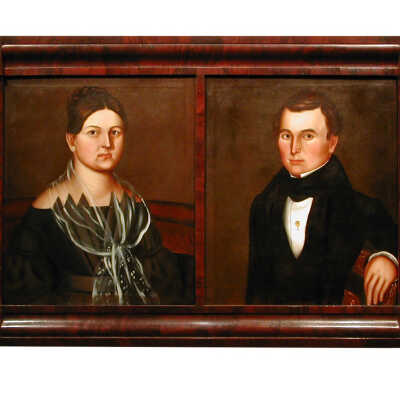
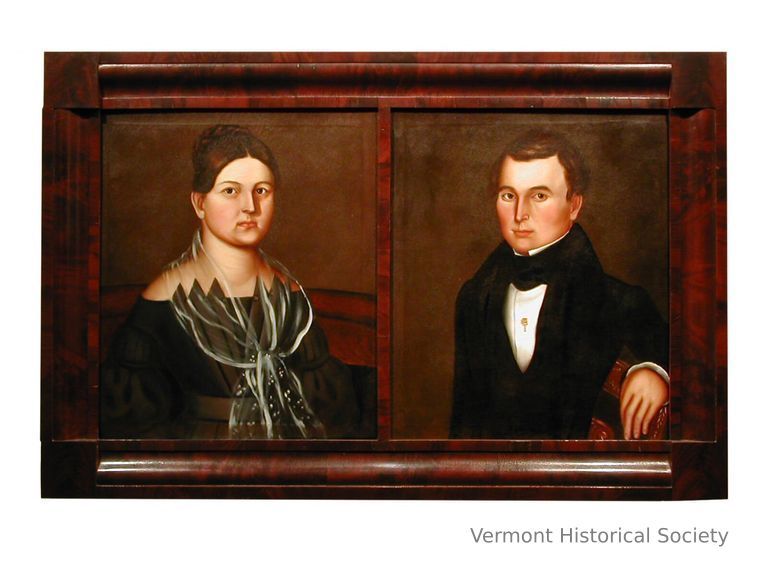
Caroline and James Stevens
Interpretative Labels
Label
James and Caroline Stevens, c. 1840
Horace Bundy (1814-1883)
Craftsbury, VT
Oil on canvas
Gift of Elizabeth C. Waldo, #A-621
James Stevens (1816-1870) was cabinet maker in Craftsbury, Vermont. His account book, in the collection of VHS, indicates that he made frames for Horace Bundy. It's very probable that Stevens made this frame.
Born in Hardwick, Vermont, Horace Bundy traveled throughout New England painting portraits until he was called to the ministry in the 1850s. His paintings are always signed in big, flowery letters on the back on the canvas.
Name/Title
Caroline and James Stevens
Type of Painting
Description
Diptych portraits showing a woman (left) and man (right), both wearing black and looking toward the viewer. The woman is wearing a black dress with an off-the-shoulder neckline and low-set sleeves. Her bodice is pleated into a v-shape with high point at the neckline. She is also wearing a transparent shawl or stole. Her dark hair is parted in the center and held in a high bun. The man is shown wearing a black, three piece suit, a white suit with a high collar, and black cravat. His brown hair is parted on the side and swept across. His left hand rests on the back of a wooden chair.
The lustrous, burl wood frame is carved into an ogee shape with a flat divider between the two paintings.
The lustrous, burl wood frame is carved into an ogee shape with a flat divider between the two paintings.
Acquisition
Accession
1991.61
Relationships
Related Places
Place
Craftsbury
Town
Orleans County
County
Vermont
State/Province
United States of America
Country
North America
Related Publications
Horace Bundy: Itinerant Portraitist
Publication
Dimensions
Context
James and Caroline Stevens lived in Craftsbury, Vermont, where James worked as a cabinetmaker.
Label from an exhibit:
"Painted by Horace Bundy in 1838.
James Stevens (1815-1870), a cabinetmaker who worked in Craftsbury, Vermont, made the frame around the two portraits. Caroline Dustin Stevens (1817-1881) married James Stevens in 1838 and it is believed the paintings were commissioned to celebrate that occasion.
Born in Hardwick, Vermont, Horace Bundy (1814-1883) apparently had no formal training as an artist, though he did work as a carriage painter early in his life. He spent much of his career in Vermont, Massachusetts, New Hampshire and New York, traveling the area as an artist and Adventist preacher."
Label from an exhibit:
"Painted by Horace Bundy in 1838.
James Stevens (1815-1870), a cabinetmaker who worked in Craftsbury, Vermont, made the frame around the two portraits. Caroline Dustin Stevens (1817-1881) married James Stevens in 1838 and it is believed the paintings were commissioned to celebrate that occasion.
Born in Hardwick, Vermont, Horace Bundy (1814-1883) apparently had no formal training as an artist, though he did work as a carriage painter early in his life. He spent much of his career in Vermont, Massachusetts, New Hampshire and New York, traveling the area as an artist and Adventist preacher."
Lexicon
Artwork Details
Medium
Oil
Subject Person
Stevens, James Wellington (1815-1870), Stevens, Caroline Dustan (1817-1881)
Made/Created
Artist Information
Bundy, Horace (1814-1883), Stevens, James Wellington (1815-1870)
Date made
circa 1840
Entry/Object ID
1991.61.1
Web Links and URLs
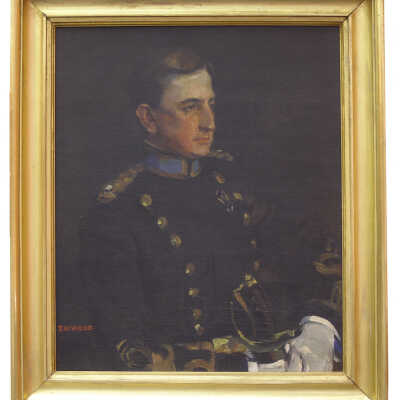

Civil War Officer
Interpretative Labels
Name/Title
Civil War Officer
Type of Painting
Lexicon
Description
Portrait showing a naval officer wearing a double-breasted uniform coat. The coat has a standing collar decorated in light blue edged with gold. He is wearing gold, braided epaulets. Addition gold braid decorates his sleeves. He is wearing white gloves and holding a sword in both of his hands. The piece is prominently signed in lower left in red: "T. W. Wood."
Acquisition
Accession
2011.13
Relationships
Related Events
Civil War
Event
Artwork Details
Medium
Oil
Subject
Military officer
Made/Created
Artist Information
Wood, Thomas Waterman (1823-1903)
Artist
Date made
1902
Dimensions
Dimension Description
Overall (unframed)
Entry/Object ID
2011.13.1

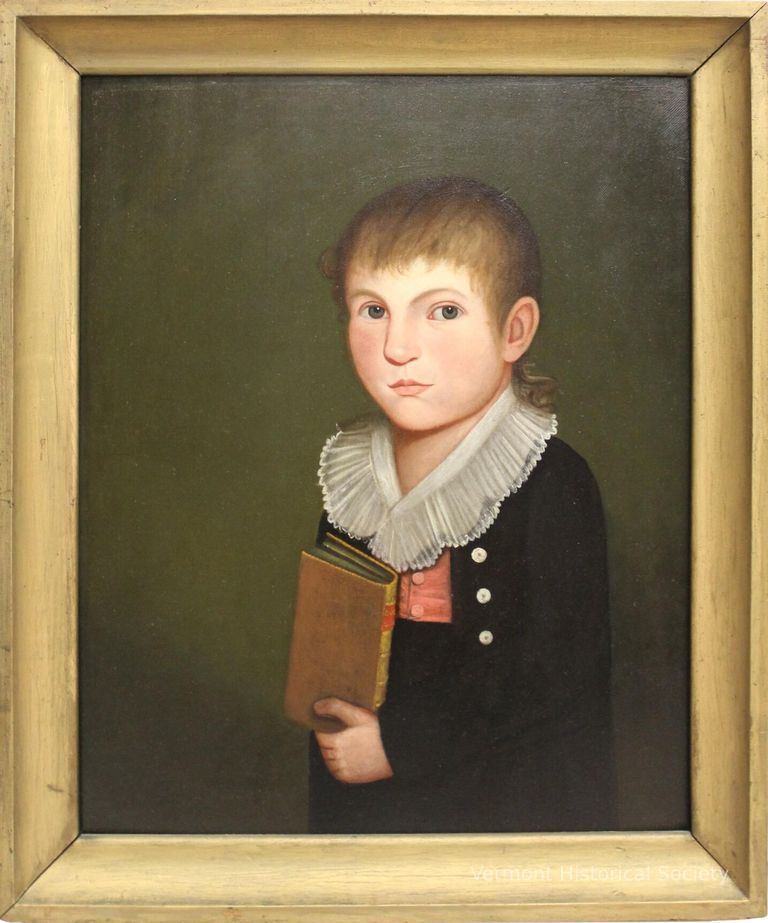
Clark Day
Interpretative Labels
Label
Clark Day, c. 1820
Attributed to Zedekiah Belknap (1781-1858)
Barre, VT
Oil on wood panel
Barre History Collection, #A-1060
Born February 5, 1811 in Barre, Vermont, Clark Day was the son of Ira and Martha Clark Day. His father, one of Barre's early residents, was a lawyer, prominent merchant, and businessman running the local tavern and helping to establish a coach line between Boston and Montreal. Although he trained to be a storekeeper, ill health forced him to take up farming.
Artis Zedekiah Belknap was a prolific itinerant artist who worked primarily in Massachusetts and New Hampshire, but made a number of trips to Vermont.
Name/Title
Clark Day
Type of Painting
Lexicon
Description
Portrait showing a young boy dressed in a black suit with a white pleated collar and red vest. His hair is cut into a mullet, and he is holding a thin book in front of himself.
Acquisition
Accession
2014.60
Artwork Details
Medium
Oil
Subject Person
Day, Clark (1811-1886)
Made/Created
Artist Information
Belknap, Zedekiah (1781-1858)
Artist
Attributed to
Attribution
Date made
circa 1820
Dimensions
Entry/Object ID
2014.60.1295
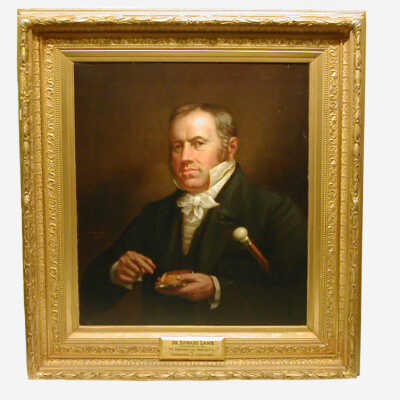
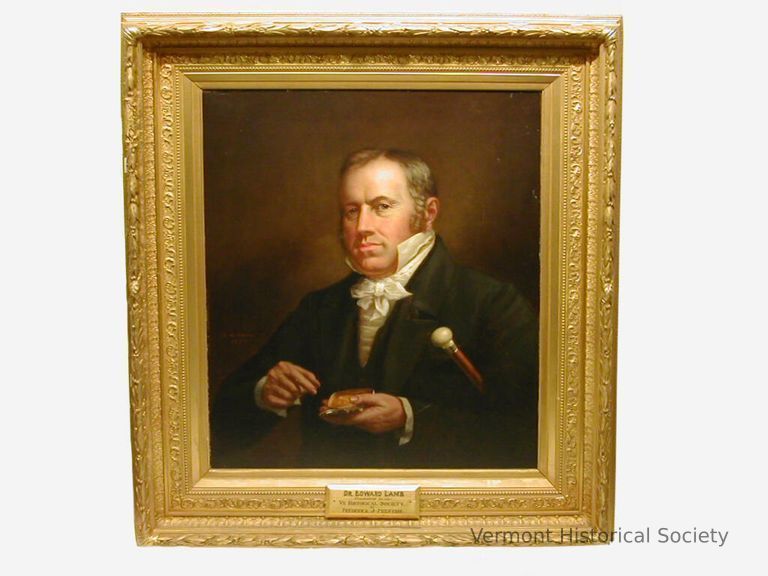
Dr. Edward Lamb
Interpretative Labels
Label
Dr. Edward Lamb, 1895
Thomas Waterman Wood (1823-1903)
Montpelier, VT
Oil on canvas
Gift of Frederick J. Prentiss, #A-121
Born in Charlton, MA in 1771, Dr. Edward Lamb served Montpelier from his arrival in 1796 until his death in 1845. Frederick Prentiss commissioned this portrait for the Vermont Historical Society well after Lamb's death.
Thomas W. Wood is arguably Montpelier's most famous artist. The son of a cabinet maker, he was largely self-taught, yet rose to the highest ranks of genre painters in the United States.
Name/Title
Dr. Edward Lamb
Lexicon
Description
Portrait showing a man in the process of taking snuff. The man is wearing a black suit, a white suit with a high collar, and a white bow tie. He has a can under his left arm with a wood shaft and a white knob. He is holding a metal case and preparing to pinch material from the case. He has long sideburns and appears to wearing an expression of annoyance.
Acquisition
Accession
1895.3
Source (if not Accessioned)
Prentiss, Frederick J.
Artwork Details
Medium
Oil
Subject Person
Lamb, Edward (1770-1845)
Made/Created
Artist Information
Wood, Thomas Waterman (1823-1903)
Artist
Date made
1895
Dimensions
Entry/Object ID
1895.3.3
Web Links and URLs
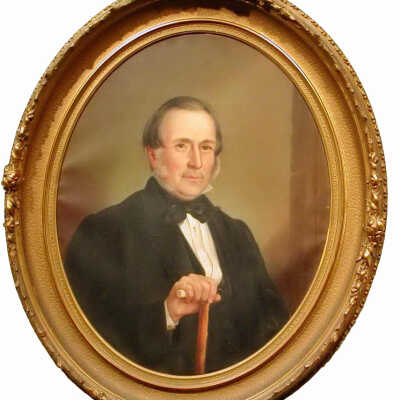

Dr. Julius Yemans Dewey
Interpretative Labels
Label
Dr. Julius Yemans Dewey
Unknown
Montpelier, VT
Oil on canvas
Gift of Emily Shipman Howland Gay, #A-576
Dr. Julius Dewey (1801-1877) practiced medicine in Montpelier, Vermont until the 1840s when he founded the National Life insurance company. What started out as a one-man operation soon turned into a major, national corporation still in operation today. His son, Admiral George Dewey, went on to fame in the Spanish American War. Susan Dewey was Dr. Dewey's third wife.
Name/Title
Dr. Julius Yemans Dewey
Type of Painting
Description
Oval portrait showing a man wearing a black three-piece suit, a white, pleated-front shirt with a high collar, and black bow tie. His grey hair is swept back and he has long, white sideburns. His right hand rests on the handle of a cane.
Acquisition
Accession
1989.23
Relationships
Related Person or Organization
Dewey, Susan Elizabeth Griggs (1816-1886)
Person or Organization
Related Places
Place
Montpelier
City
Washington County
County
Vermont
State/Province
United States of America
Country
North America
Dimensions
Context
Dr. Dewey was the founder of National Life insurance company and the father of Spanish-American War hero Admiral George Dewey.
Lexicon
Artwork Details
Medium
Oil
Subject Person
Dewey, Julius Yemans (1801-1877)
Subject
Portrait
Made/Created
Date made
circa 1860
Entry/Object ID
1989.23.2
Web Links and URLs

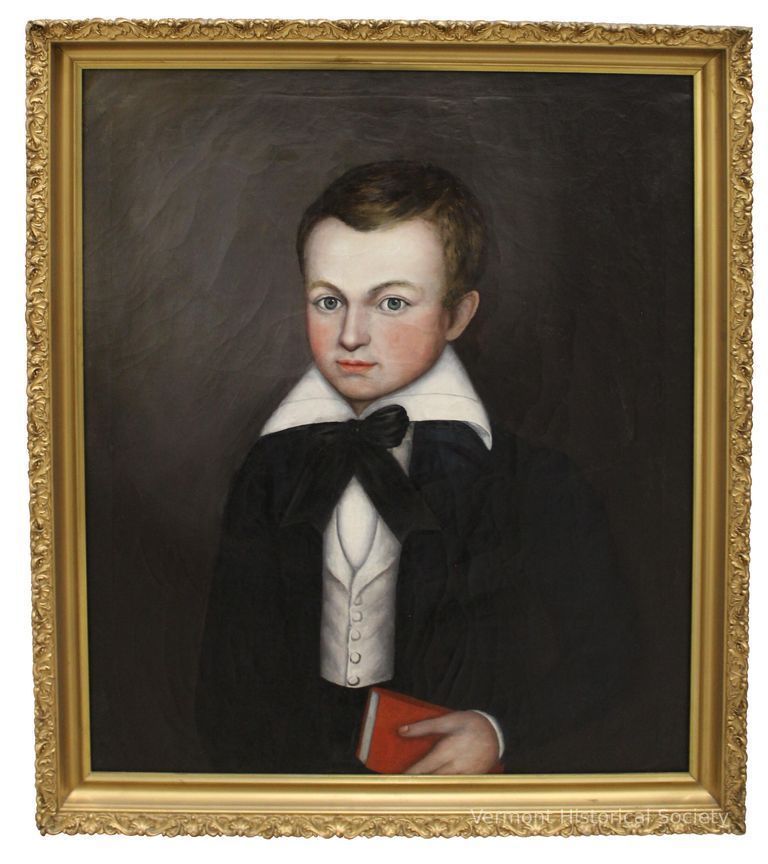
Edward Kinsman
Interpretative Labels
Label
Edward Kinsman, c. 1836
Uknown Artist
Barre, VT
Oil on canvas
Barre History Collection, #A-1163
Newell Kinsman (1795-1858) moved to Barre as a young lawyer and quickly established the leading law firm in town. This remarkable family group illustrates the talent of itinerant portrait painters of the day. Included in the group are his wife Leonora Lamb Kinsman (1810-1856) and their three children, George (b. 1829), Edward (b. 1831), and Ellen (b. 1833).
Name/Title
Edward Kinsman
Type of Painting
Lexicon
Description
Portrait showing a young boy in a three-piece suit consisting of a black jacket and pants and white vest. He's wearing a white shirt with a wide fall collar and black bow tie. He is holding a red book.
Acquisition
Accession
2014.60
Artwork Details
Medium
Oil
Subject Person
Kinsman, Edward
Made/Created
Date made
circa 1836
Entry/Object ID
2014.60.1374
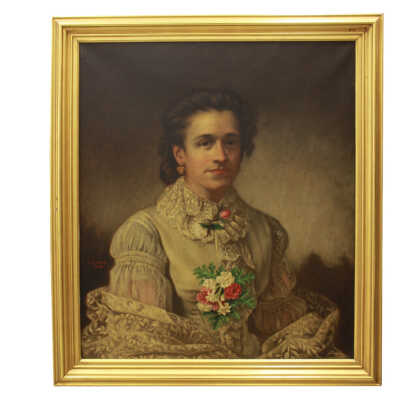
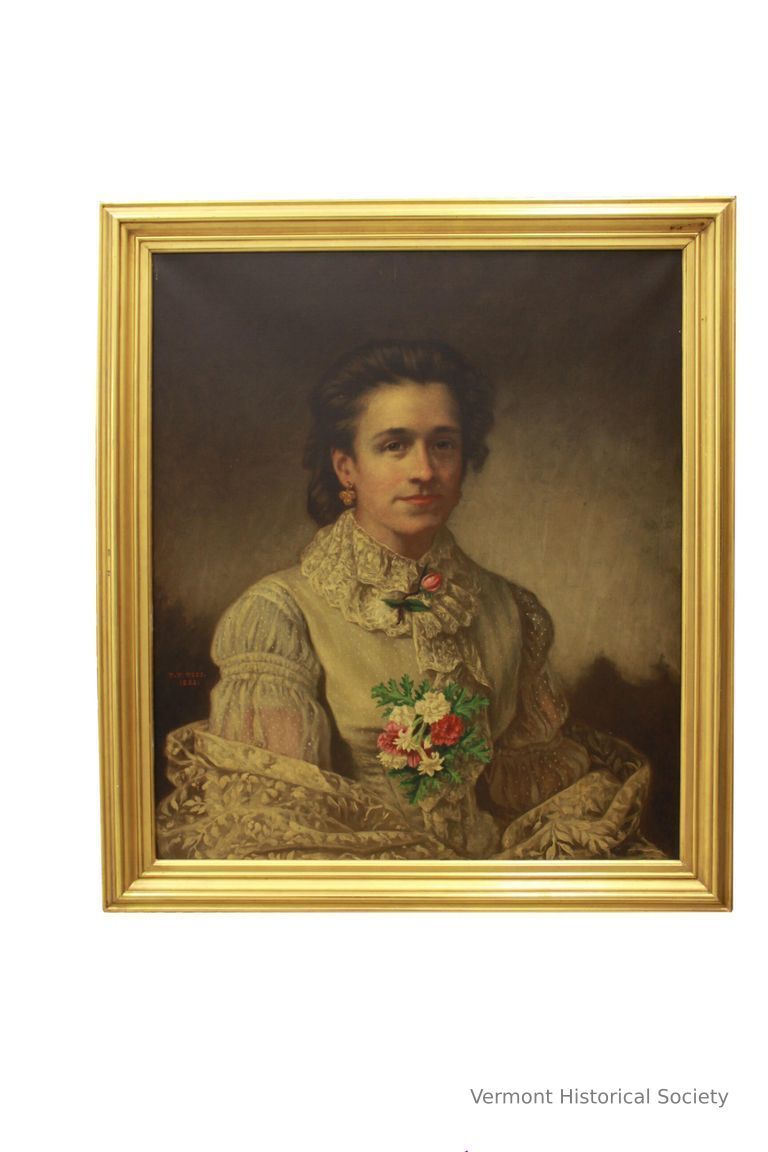
Ella Luthera Dewey Pitkin
Interpretative Labels
Label
Ella Luthera Dewey Pitkin, 1883
Thomas Waterman Wood (1823-1903)
Montpelier, VT
Oil on canvas
Gift of J. Brooks Buxton, #A-945
Ella Luthera Dewey Pitkin (1850-1879) was the second daughter of Charles and Betsy Tarbox Dewey and granddaughter of Julius Dewey. She married Carrol Pitkin in 1873 but died young in 1879. This portrait is one of two commissioned by the family from Thomas Waterman Wood after her death.
Thomas W. Wood is arguably Montpelier's most famous artist. The son of a cabinet maker, he was largely self-taught, yet rose to the highest ranks of genre painters in the united states.
Name/Title
Ella Luthera Dewey Pitkin
Type of Painting
Lexicon
Description
Portrait showing a young woman wearing a white lace dress embellished with a bouquet of brightly-colored flowers. The dress has a high, ruffled lace collar with a rose bud and stem pinned at the center. The translucent sleeves are gathered into poofs. A posy of pink and white flowers with green foliage is pinned to her chest at center. She is holding a lace shawl. Her hair is swept back from her face and held in a simple style.
Acquisition
Accession
2011.13
Artwork Details
Medium
Oil
Subject Person
Pitkin, Ella Luthera Dewey (1850-1879)
Made/Created
Artist Information
Wood, Thomas Waterman (1823-1903)
Artist
Date made
1883
Dimensions
Entry/Object ID
2011.13.2
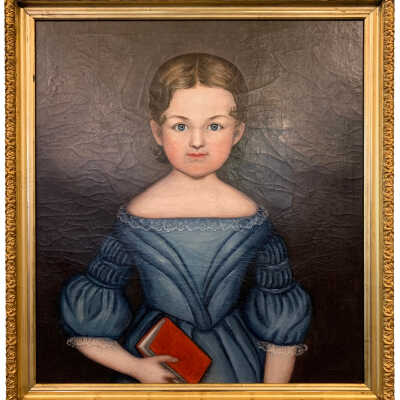
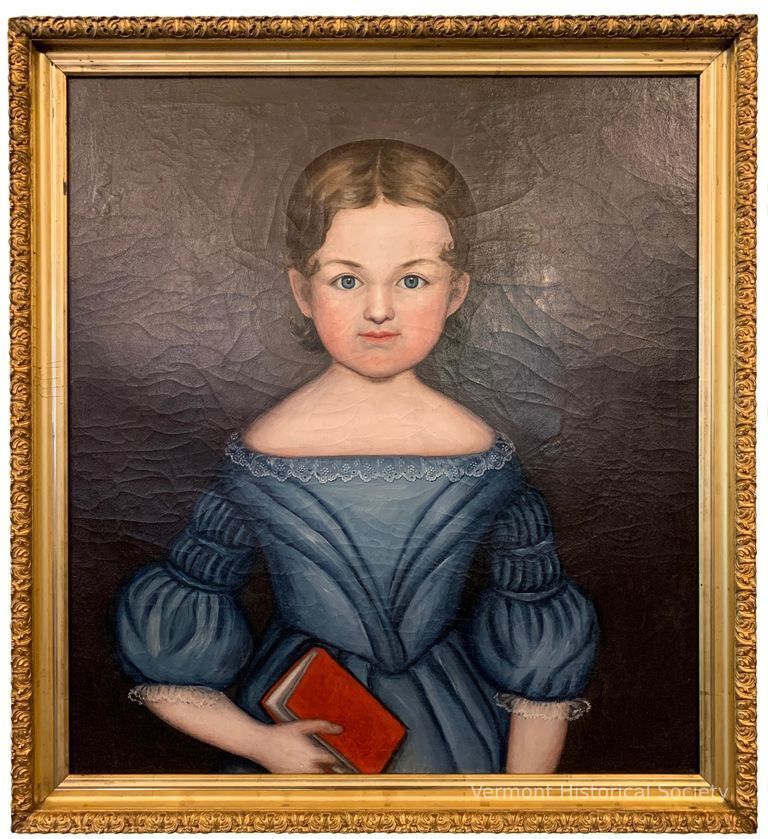
Ellen Kinsman
Interpretative Labels
Label
Ellen Kinsman, c. 1836
Unknown Artist
Barre, VT
Barre History Collection, #A-1164
Newell Kinsman (1795-1858) moved to Barre as a young lawyer and quickly established the leading law firm in town. This remarkable family group illustrates the talent of itinerant portrait painters of the day. Included in the group are his wife Leonora Lamb Kinsman (1810-1856) and their three children, George (b. 1829), Edward (b. 1831), and Ellen (b. 1833).
Name/Title
Ellen Kinsman
Type of Painting
Lexicon
Description
Portrait showing a young girl wearing a blue dress. The dress has an off-the-shoulder neckline edged in narrow lace, with low set sleeves gathered into three sections. The bodice pleats into a v-shape at the waist. She is holding a red book.
Acquisition
Accession
2014.60
Artwork Details
Medium
Oil
Subject Person
Kinsman, Ellen
Made/Created
Date made
circa 1836
Entry/Object ID
2014.60.1375
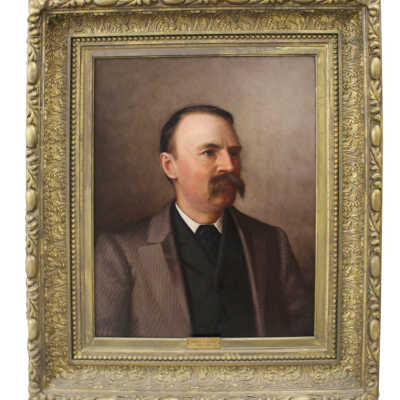
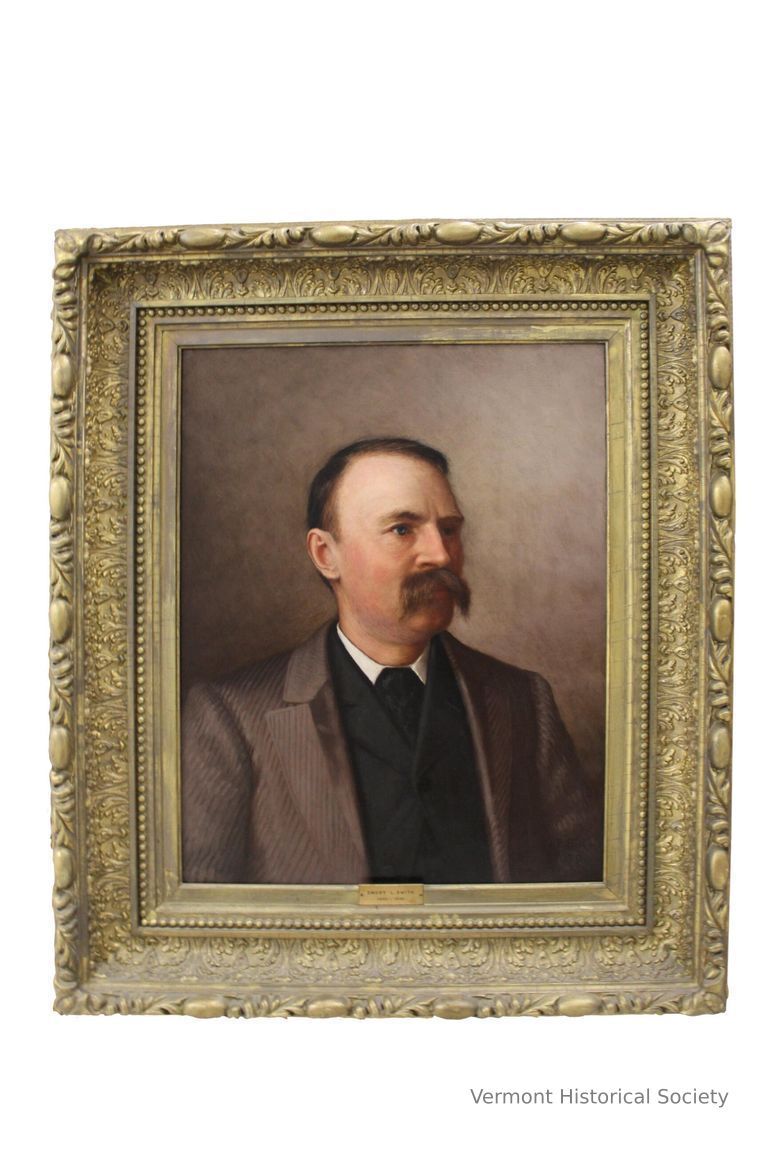
Emery L. Smith
Interpretative Labels
Label
Emery L. Smith, c. 1895
James Franklin Gilman (1842-1929)
Barre, VT
Oil on canvas
Barre History Collection, #A-1082
Emery L. Smith (1842-1929) helped found the granite industry in Barre and served as the newly incorporated city's first mayor in 1895.
Name/Title
Emery L. Smith
Type of Painting
Lexicon
Description
Impressionistic portrait showing a man in a brown and green suit jacket, a black vest, black tie, and white shirt with a fall collar. The man has a slightly receding hairline cut close to the head and large mustache that curls low below his mouth. The background is a gradient of brown, from light to dark. The painting is in a wide, gilded frame with molded acanthus and oak leaves. At the bottom center of the frame is a small plaque with the inscription, "EMERY L. SMITH/1895-1896".
Acquisition
Accession
2014.60
Relationships
Related Places
Place
Barre City
City
Washington County
County
Vermont
State/Province
United States of America
Country
North America
Artwork Details
Medium
Oil
Subject Person
Smith, Emery L. (1842-1929)
Made/Created
Artist Information
Gilman, James Franklin (1850-1929)
Artist
Painter
Role
Date made
circa 1895
Dimensions
Dimension Description
Overall
Entry/Object ID
2014.60.1317
Web Links and URLs
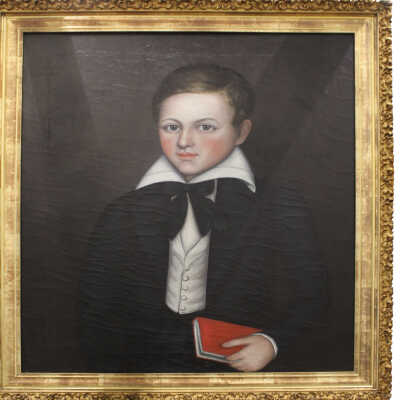
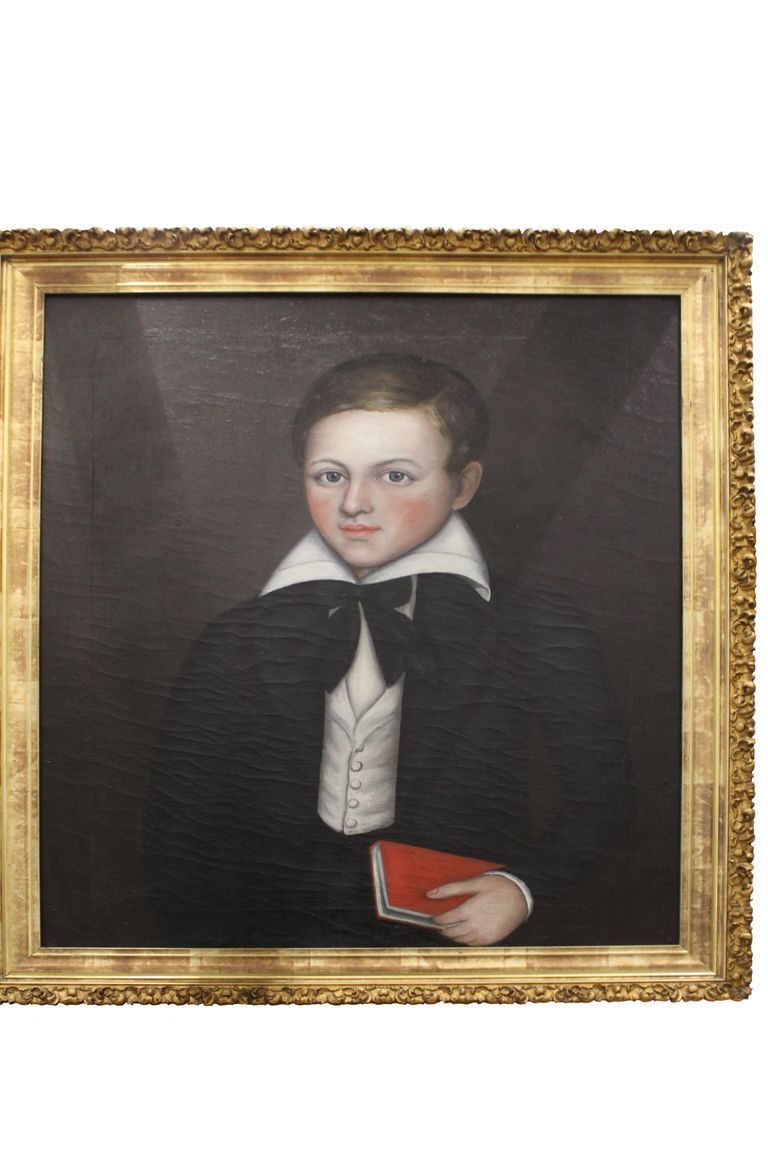
George Lamb Kinsman
Interpretative Labels
Label
George Lamb Kinsman, c. 1836
Unknown Artist
Barre, VT
Oil on canvas
Barre History Collection, #A-1162
Newell Kinsman (1795-1858) moved to Barre as a young lawyer and quickly established the leading law firm in town. This remarkable family group illustrates the talent of itinerant portrait painters of the day. Included in the group are his wife Leonora Lamb Kinsman (1810-1856) and their three children, George (b. 1829), Edward (b. 1831), and Ellen (b. 1833).
Name/Title
George Lamb Kinsman
Type of Painting
Lexicon
Description
Portrait showing a young boy in a three-piece suit consisting of a black jacket and pants and white vest. He's wearing a white shirt with a wide fall collar and black bow tie. He is holding a red book.
Acquisition
Accession
2014.60
Artwork Details
Medium
Oil
Subject Person
Kinsman, George Lamb
Made/Created
Date made
circa 1836
Entry/Object ID
2014.60.1373


Henry Stevens
Interpretative Labels
Label
Henry Stevens, 1834
Unknown Artist
Barnet, VT
Oil on canvas
GIft of Mrs. Benjamin Franklin Stevens, #A-149
Henry Stevens (1791-1867), of Barnet, Vermont, was somewhat of a Renaissance man. He farmed, ran an inn, kept the toll road, served his town in the legislature, and had a reputation as Vermont's greatest antiquarian. Along with three other gentlemen, he founded the Vermont Historical Society through an act of the legislature in 1838. He served for 18 years as its president.
Name/Title
Henry Stevens
Type of Painting
Lexicon
Description
Portait of a man wearing a black suit jacket, white shirt with a high fall collar, and a black cravat or tie. He has long sideburns and wispy hair on his forehead. His left arm is draped casually on the back of an inlaid wooden side chair, and his is holding a newspaper with the date 1834.
Acquisition
Accession
1903.4
Relationships
Related Person or Organization
Stevens, Candace Salter (1792-1874)
Person or Organization
Artwork Details
Medium
Oil
Subject Person
Stevens, Henry (1791-1867)
Made/Created
Date made
1834
Dimensions
Entry/Object ID
1903.4.1
Context
Henry Stevens was the founder of the Vermont Historical Society.

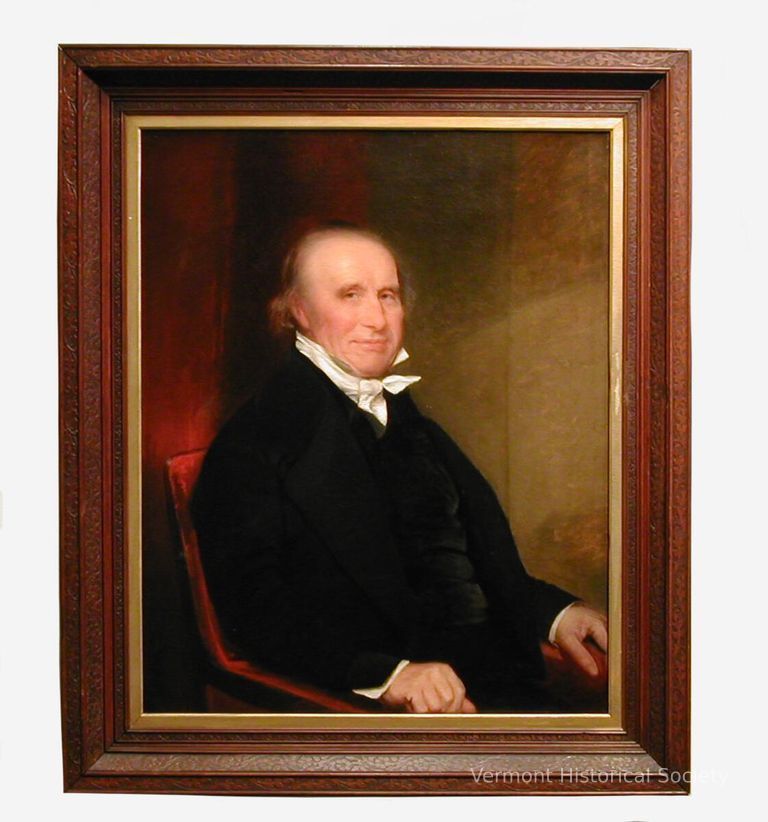
Honorable William Jarvis
Interpretative Labels
Label
Honorable William Jarvis, c. 1850
Unknown Artist
Weathersfield, VT
Oil on canvas
Gift of Mrs. Leavitt Jarvis Hunt, #A-120
William Jarvis of Weathersfield, Vermont, served as the consul to Lisbon and Charge d'Affairs to Portugal under Presidents Jefferson and Madison. His time on the Iberian peninsula introduced him to the prized Merino sheep. Upon his return to Vermont, he became the largest importer of Merino sheep to the United States. The resulting sheep craze transformed Vermont's landscape and economy for decades to come.
Name/Title
Honorable William Jarvis
Type of Painting
Lexicon
Description
Portrait showing an older man with a jovial expression, looking directly at the viewer. He is seated in profile and wearing a black suit, white shirt with a high collar, and a white cravat. He has a receding hairline, but shoulder-length gray hair in the back. He is seated in a red armchair. His left hand is clenched, but his right hand remains loose on the arm of the chair.
Acquisition
Accession
1961.53
Artwork Details
Medium
Oil
Subject Person
Jarvis, William (1770–1859)
Made/Created
Date made
circa 1850
Dimensions
Entry/Object ID
1961.53.1
Web Links and URLs
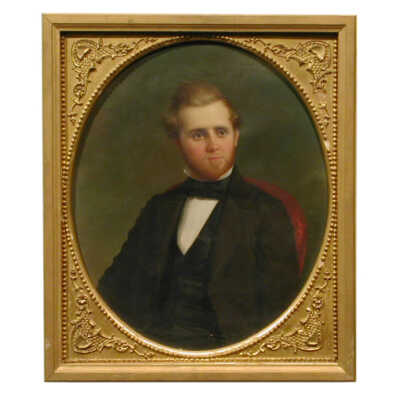
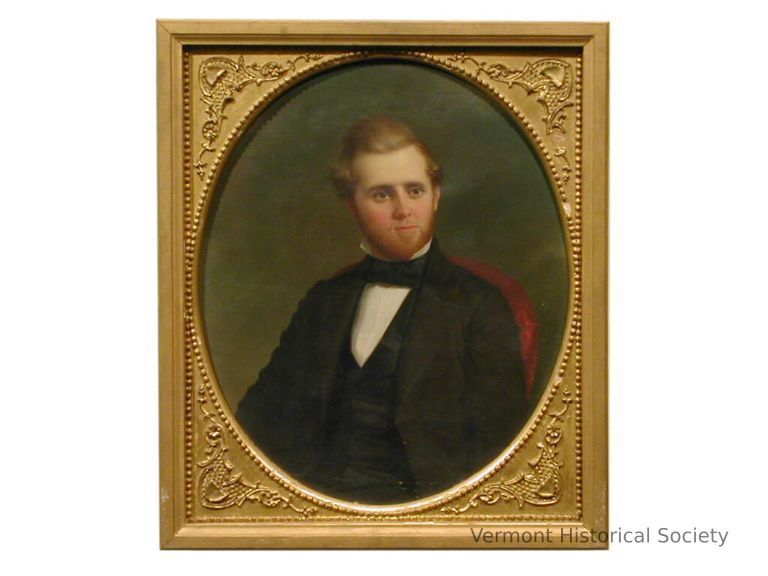
John F. Lincoln
Interpretative Labels
Label
John F. Lincoln, c.1860
Unknown Artist
Pittsford, VT
Oil on canvas
#A-117
Name/Title
John F. Lincoln
Lexicon
Description
Oval portrait showing a man wearing a black suit jacket and vest, a white shirt with a high collar, and a black tie. He has light brown hair and a small beard beneath rosy cheeks. He is sitting in a red chair.
Acquisition
Accession
1966.72
Artwork Details
Medium
Oil
Subject Person
Lincoln, John Fenton (1828-1889)
Made/Created
Date made
circa 1860
Dimensions
Entry/Object ID
1966.72.18
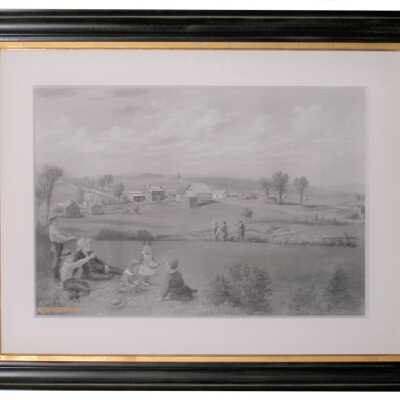
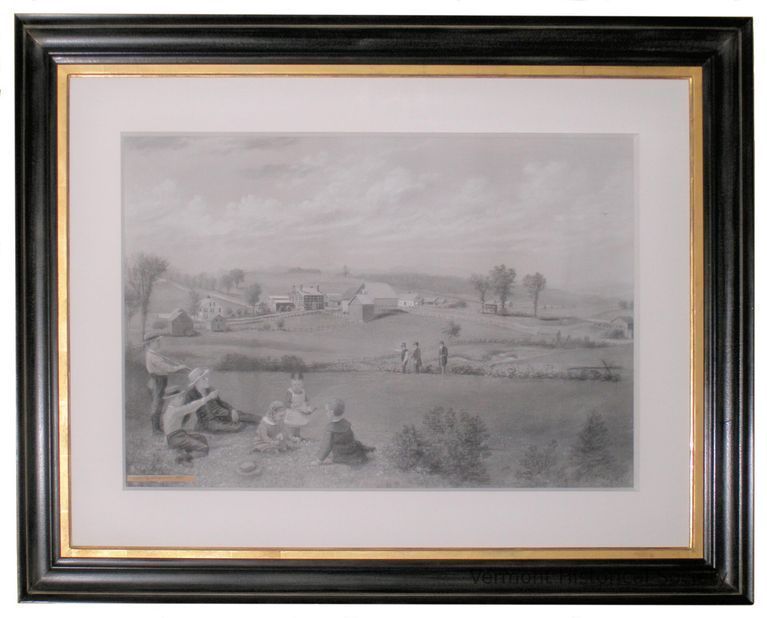
Kent Family at Kent's Corner
Interpretative Labels
Label
Kent Family at Kent's Corner, 1882
James Franklin Gilman (1842-1929)
Calais, VT
Charcoal on paper
Gift of J. Brooks Buxton, #A-788
This drawing depicts the area of Calais known as Kent's Corners due to the large number of Kent families that lived there. The building known as Kent Tavern once belonged to Vermont Historical Society and is now a Vermont State Historic Site. The people pictured are all descendants of patriarch Abdiel Kent.
James Gilman was a prolific landscape painter throughout Washington County in the late-19th century.
Name/Title
Kent Family at Kent's Corner
Lexicon
Description
Charcoal landscape drawing showing a family of six lounging on the bank of a river. Three additional people walk along the opposite bank, and a small town centered along a road can be seen beyond them. The buildings consist primarily of white structures with the notable exception of a stately brick house at the center. The landscape consists or rolling hills, partitioned with fences and sparsely dotted with trees.
Acquisition
Accession
2007.13
Relationships
Related Person or Organization
Kent, Dorman B.E. (1875-1951)
Person or Organization
Related Places
Place
Calais
Town
Washington County
County
Vermont
State/Province
United States of America
Country
North America
Artwork Details
Medium
Charcoal
Subject
Kent family
Made/Created
Artist Information
Gilman, James Franklin (1850-1929)
Artist
Painter
Role
Date made
1882
Dimensions
Dimension Description
Overall (framed)
Entry/Object ID
2007.13.1
Context
This drawing depicts the area of Calais known as Kent's Corners due to the large number of Kent families that lived there. The building known as Kent Tavern once belonged to Vermont Historical Society and is now a Vermont State Historic Site. The people pictured are all descendants of patriarch Abdiel Kent.
James Gilman was a prolific landscape painter throughout Washington County in the late-19th century.
James Gilman was a prolific landscape painter throughout Washington County in the late-19th century.

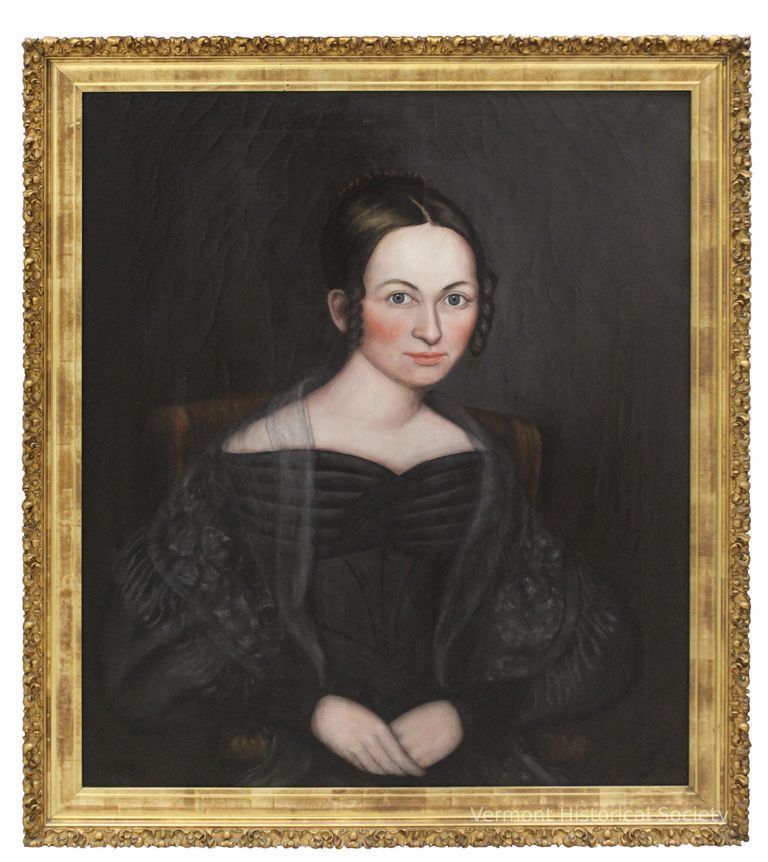
Leonora Lamb Kinsman
Interpretative Labels
Label
Leonora Lamb Kinsman, c. 1836
Unknown Artist
Barre, VT
Oil on canvas
Barre History Collection, #A-1161
Newell Kinsman (1795-1858) moved to Barre as a young lawyer and quickly established the leading law firm in town. This remarkable family group illustrates the talent of itinerant portrait painters of the day. Included in the group are his wife Leonora Lamb Kinsman (1810-1856) and their three children, George (b. 1829), Edward (b. 1831), and Ellen (b. 1833).
Name/Title
Leonora Lamb Kinsman
Type of Painting
Lexicon
Description
Portrait showing a woman in a black dress. The dress has an off-the-shoulder neckline with several pleats across the breast and low-set, full sleeves. She is draped across the shoulders with a translucent shawl. Her dark hair is parted in the center and looped in braids around her ears.
Acquisition
Accession
2014.60
Artwork Details
Medium
Oil
Subject Person
Kinsman, Leonora (1810-1856)
Made/Created
Date made
circa 1836
Entry/Object ID
2014.60.1372
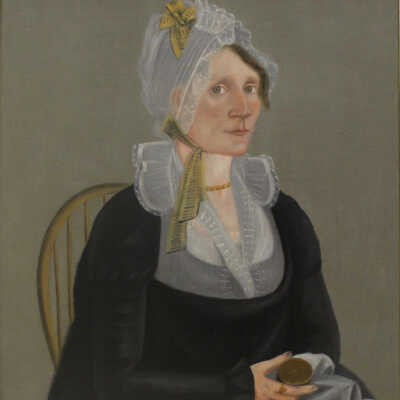
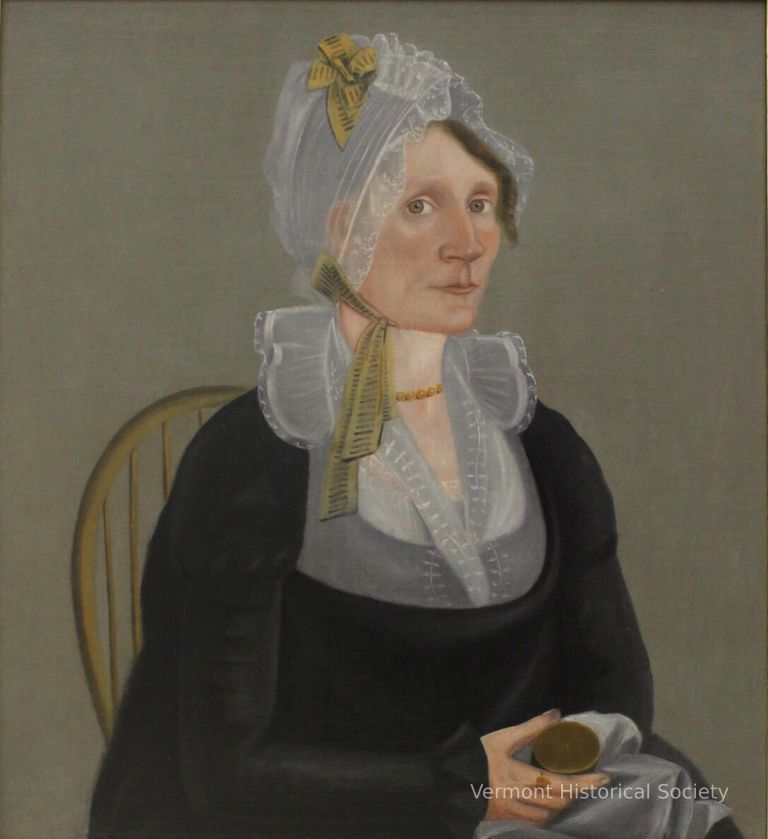
Lydia Powers Paddock
Interpretative Labels
Label
Lydia Powers Paddock, c. 1790
Attributed to Winthrop Chandler (1747-1790)
Worcester, MA
Oil on canvas
Barre History Collection, #A-1071
Lydia Powers, aunt of famed Vermont sculptor Hiram Powers, married Dr. Robert Paddock of Woodstock and, in 1814, moved to Barre.
Unlike other portrait artists of the day, Winthrop Chandler did not travel. Instead, subjects came to his home in either Massachusetts or Connecticut.
Name/Title
Lydia Powers Paddock
Type of Painting
Lexicon
Description
Portrait showing a woman wearing a black, apron-front dress with a translucent, white collar and cap. The cap is ruffled around her face and along the top of her head, and is both decorated and held beneath her chin with green striped ribbon. The collar pins the front of the gown below the neckline, showing an additional white layer worn underneath the main gown. She is holding a small, round tin on a white handkerchief or apron, and is wearing a ring with a heart-shaped head. She is sitting in a yellow Windsor chair.
Acquisition
Accession
2014.60
Relationships
Related Places
,
Artwork Details
Medium
Oil
Subject Person
Paddock, Lydia Powers (1772-1815)
Made/Created
Artist Information
Chandler, Winthrop
Artist
Attributed to
Attribution
Date made
circa 1790
Dimensions
Entry/Object ID
2014.60.1306
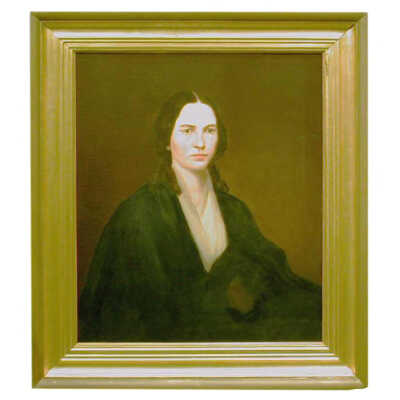
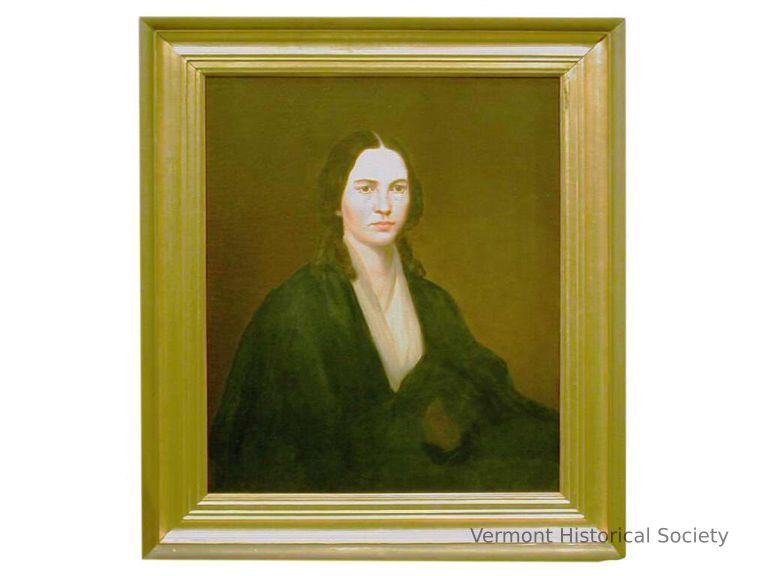
Margaret Fay Brown
Interpretative Labels
Label
Margaret Fay Brown, c. 1857
Unknown Artist
Bennington, VT
Oil on canvas
Gift of Margaret Fay Shaw Campbell, #A-598
Margaret Hyde Fay Brown (1833-1922) came from the prominent Fay family of Bennington. Her grandfather, Stephen Fay, owned what we now call the Catamount Tavern during the American Revolution.
Name/Title
Margaret Fay Brown
Type of Painting
Lexicon
Description
Portrait showing a dark-haired woman in seated pose. She is wearing a dark gown with a low center-front split and a white blouse or shawl under the outer robe. Her hair is parted down the center and is held in ringlets at the nape of her neck.
Acquisition
Accession
1990.20
Artwork Details
Medium
Oil
Subject Person
Brown, Margaret Hyde Fay (1833-1922)
Made/Created
Artist Information
Lawman, Jasper Holman
Artist
Possibly
Attribution
Date made
1855-1857
Dimensions
Dimension Description
Overall
Entry/Object ID
1990.20.3
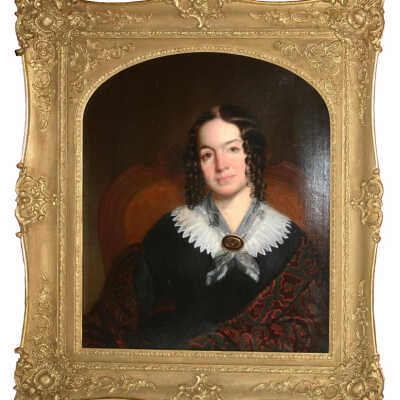
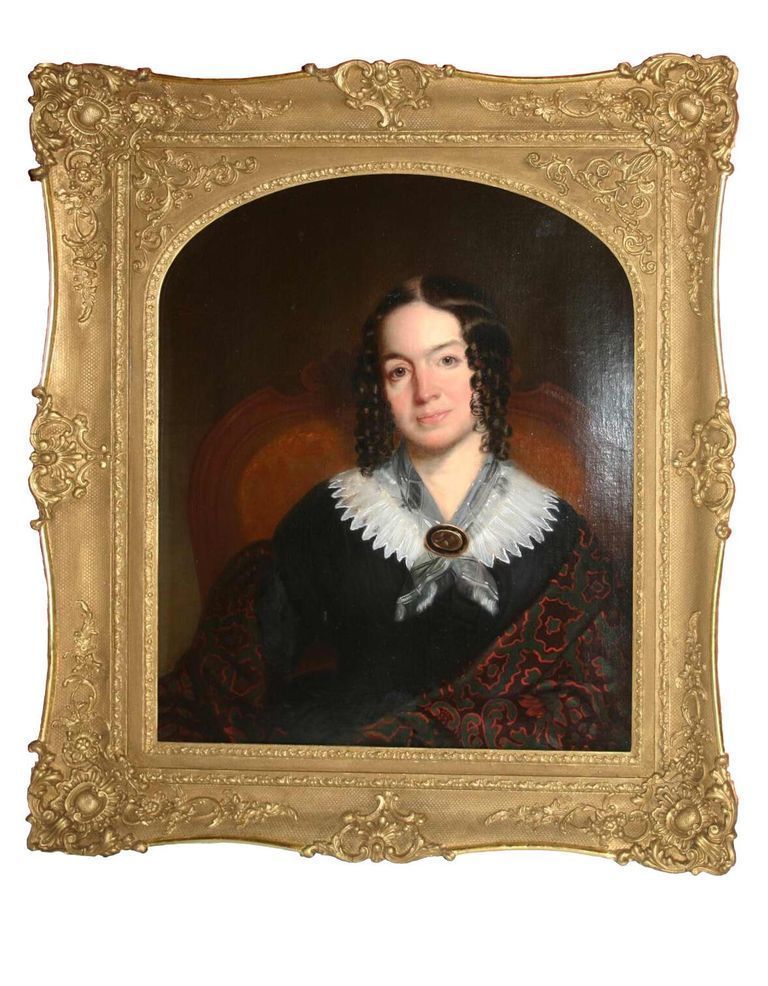
Mary Ann Williams
Interpretative Labels
Label
Mary Ann Williams, c. 1845
Benjamin Franklin Mason (1804-1871)
Woodstock, VT
Oil on canvas
#A-761
Norman and Mary Ann Williams were prominent citizens of Woodstock. He held numerous town, county, and state offices, including a seat on the commission that oversaw the design of the third Vermont State House. Their son, Dr. Edward Williams, built the town library on the site of their home in 1884 and named it after Norman.
Benjamin Mason traveled throughout the northern tier of the United States producing portraits of many prominent citizens. He's known to have visited Woodstock a number of times.
Name/Title
Mary Ann Williams
Type of Painting
Lexicon
Description
Portrait showing a woman wearing a black dress with a pleated, white lace collar. Around her neck she is wearing a translucent, blue scarf pinned at center front with an oval mourning brooch. The brooch is a black oval with a central portion containing hair held in a woven design. She is wrapped in a paisley shawl and sitting on a red upholstered chair. Her hair is parted in the center and falls in ringlets on either side.
Acquisition
Accession
2006.6
Artwork Details
Medium
Oil
Subject Person
Williams, Mary Ann Wentworth Brown (1795-1879)
Made/Created
Artist Information
Mason, Benjamin Franklin (1804-1871)
Artist
Date made
1840-1850
Dimensions
Dimension Description
Overall (framed)
Entry/Object ID
2006.6.2
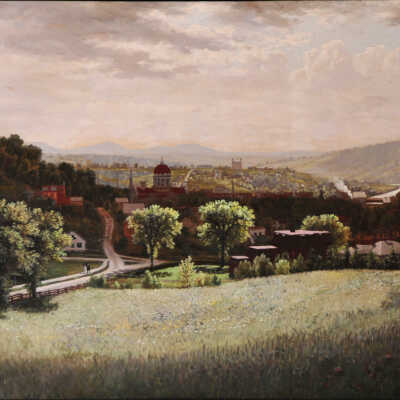
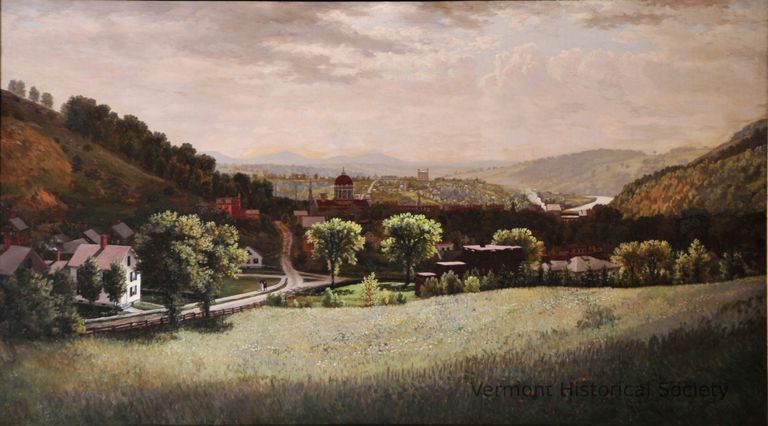
Montpelier from Col. Jewett's Hill
Interpretative Labels
Label
Montpelier from Col. Jewett's Hill, 1891
James Franklin Gilman (1842-1929)
Montpelier, VT
Oil on canvas
Gift of Louise Andrews Kent, 1974.39.1
This view of Montpelier from what is now Terrace Street provides a great picture of Montpelier at the cusp of the 20th century. Notice the red painted dome of the State House and the prominent Montpelier Seminary in the background.
James Gilman was a prolific landscape painter throughout Washington County in the late 19th century. A number of his works can be found elsewhere in this gallery.
Name/Title
Montpelier from Col. Jewett's Hill
Type of Painting
Lexicon
Description
Painting showing a distant view of a city situated in a valley between multiple mountains. There is a white house on the left edge of the painting along a road lined with mature trees and leading into the city in the distance. The dome of the capital rises in the middle distance, and the rectangular form of the seminary is prominently visible in the distance. Several other domestic and business structures line the roads. The mountains and hills surrounding the city alternate between forest and fields, and the sky is filled with clouds.
Acquisition
Accession
1974.39
Artwork Details
Medium
Oil
Subject
Montpelier as seen from Terrace Street
Made/Created
Artist Information
Gilman, James Franklin (1850-1929)
Artist
Painter
Role
Date made
1891
Dimensions
Entry/Object ID
1974.39.1
Context
Painted by James Franklin Gilman near Montpelier in 1891.
Web Links and URLs


Newell Kinsman
Interpretative Labels
Label
Newell Kinsman, c. 1836
Unknown Artist
Barre, VT
Oil on canvas
Barre History Collection, #A-1160
Newell Kinsman (1795-1858) moved to Barre as a young lawyer and quickly established the leading law firm in town. This remarkable family group illustrates the talent of itinerant portrait painters of the day. Included in the group are his wife Leonora Lamb Linsman (1810-1856) and their three children, George (b. 1829), Edward (b. 1831), and Ellen (b. 1833)
Name/Title
Newell Kinsman
Type of Painting
Lexicon
Description
Portrait showing a man wearing a black-three piece suit, a white shirt with a high collar, and a large, black bow tie. He has curly hair and appears to be looking directly at the viewer.
Acquisition
Accession
2014.60
Artwork Details
Medium
Oil
Subject Person
Kinsman, Newell (1795-1858)
Made/Created
Date made
circa 1836
Entry/Object ID
2014.60.1371
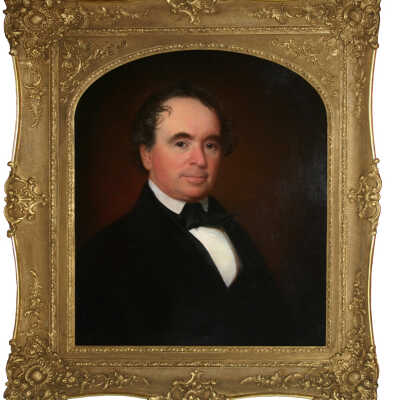
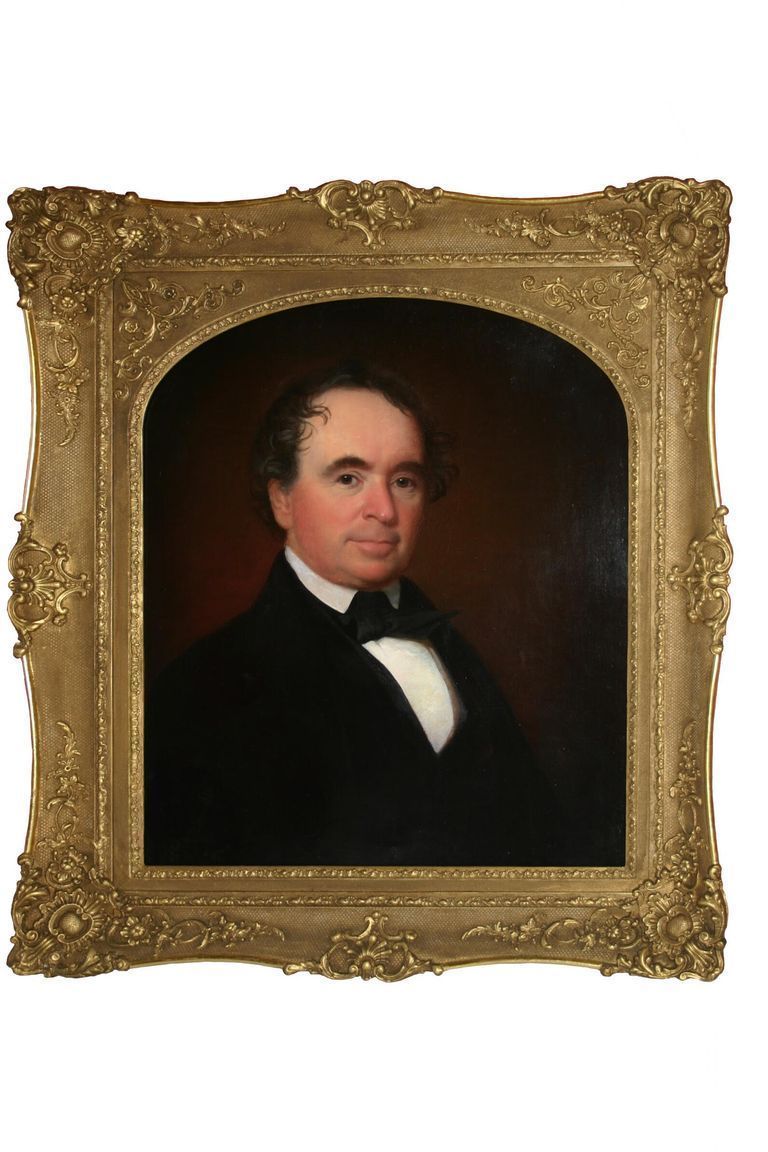
Norman Williams
Interpretative Labels
Label
Norman Williams, c. 1845
Benjamin Franklin Mason (1804-1871)
Woodstock, VT
Oil on canvas
#A-761
Norman and Mary Ann Williams were prominent citizens of Woodstock. He held numerous town, county, and state offices, including a seat on the commission that oversaw the design of the third Vermont State House. Their son, Dr. Edward Williams, built the town library on the site of their home in 1884 and named it after Norman.
Benjamin Mason traveled throughout the northern tier of the United States producing portraits of many prominent citizens. He's known to have visited Woodstock a number of times.
Name/Title
Norman Williams
Type of Painting
Lexicon
Description
Portrait showing a man wearing a black, three-piece suit, a white shirt with a fall collar, and black tie. His hairline has receded significantly, but wisps of hair have been brushed forward to disguise it.
The golden frame is very ornate, with an arched top to the opening and elaborately molded borders.
The golden frame is very ornate, with an arched top to the opening and elaborately molded borders.
Acquisition
Accession
2006.6
Relationships
Related Person or Organization
Williams, Norman (1791-1868)
Person or Organization
Artwork Details
Medium
Oil
Subject Person
Williams, Norman (1791-1868)
Made/Created
Artist Information
Mason, Benjamin Franklin (1804-1871)
Artist
Date made
1840-1850
Dimensions
Dimension Description
Overall (framed)
Entry/Object ID
2006.6.1

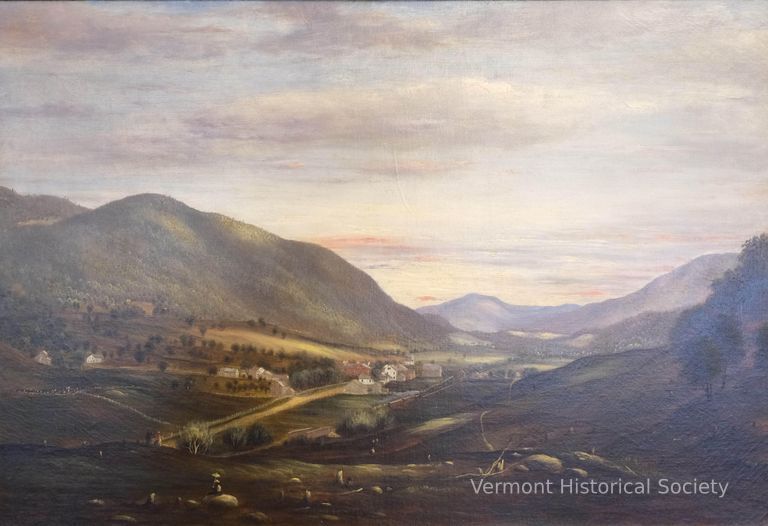
North Dorset
Interpretative Labels
Label
North Dorset, late 19th century
Unknown Artist
Dorset, VT
Oil on canvas
Gift of Norman Dieter, #A-161
Landscape view of North Dorset, Vermont, in the style of the Hudson River School.
Name/Title
North Dorset
Type of Painting
Lexicon
Description
Painting of a landscape showing a wide valley between several mountains. A town center is at the center of the composition, consisting of several buildings, with roads leading outward from the center, primarily to the left of the composition. The valley is dotted throughout with houses, trees, and fields. The mountains on either side are tree covered with varied lighting from cloud cover.
Acquisition
Accession
1972.65
Artwork Details
Medium
Oil
Made/Created
Time Period
19th Century
Dimensions
Entry/Object ID
1972.65.1


Sen. Justin Morrill
Interpretative Labels
Label
Sen. Justin Morrill, 1892
Thomas Waterman Wood (1823-1903)
Montpelier, VT
Oil on canvas
Gift of Thomas Waterman Wood, #A-164
Sen. Justin Morrill served Vermont in the United States House of Representatives from 1855 to 1867 and in the United States Senate from 1867 to 1898. He helped found the Republican party, assisted in drafting the 14th Amendment, and, most famously, wrote the legislation that created the land-grant college system. His home in Strafford is now a Vermont State Historic Site.
Thomas W. Wood is arguably Montpelier's most famous artist. The son of a cabinet maker, he was largely self-taught, yet rose to the highest ranks of genre painters in the United States.
Name/Title
Sen. Justin Morrill
Type of Painting
Lexicon
Description
Portrait showing and older man wearing a black three-piece suit, a white shirt with a stand collar, and a black bow tie. He is shown sitting in carved, wooden arm chair holding a newspaper in his right hand and spectacles in his left hand. His grey hair is parted on the side, and he has long sideburns extending toward his mouth in muttonchops. The painting is in an ornate gold frame with carved or molded acanthus leaves.
Acquisition
Accession
1894.4
Artwork Details
Medium
Oil
Subject Person
Morrill, Justin Smith (1810-1898)
Made/Created
Artist Information
Wood, Thomas Waterman (1823-1903)
Artist
Date made
1892
Dimensions
Entry/Object ID
1894.4.1
Web Links and URLs
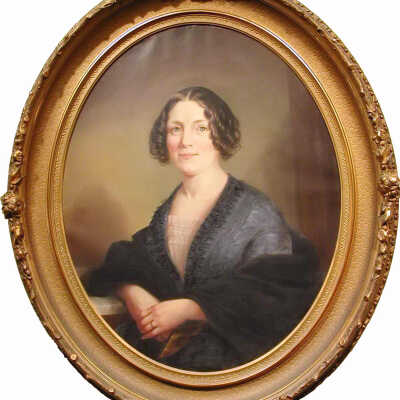

Susan Elizabeth Griggs Dewey
Interpretative Labels
Label
Susan Elizabeth Griggs Dewey
Unknown
Montpelier, VT
Oil on canvas
Gift of Emily Shipman Howland Gay, #A-577
Dr. Julius Dewey (1801-1877) practiced medicine in Montpelier, Vermont until the 1840s when he founded the National Life insurance company. What started out as a one-man operation soon turned into a major, national corporation still in operation today. His son, Admiral George Dewey, went on to fame in the Spanish American War. Susan Dewey was Dr. Dewey's third wife.
Name/Title
Susan Elizabeth Griggs Dewey
Type of Painting
Lexicon
Description
Oval portrait of a woman seating wearing a blue gown with a pink central bodice and black, fur shawl. Her dark hair is curled close to her head and held in a chin-length style and she has a small smile. Her dress is embellished with self-fabric ruffles along the center edges. She is draping her right arm on a white marble table and loosely clasping her hands in front of her.
Acquisition
Accession
1989.23
Relationships
Related Person or Organization
Dewey, Julius Yemans (1801-1877)
Person or Organization
Artwork Details
Medium
Oil
Subject Person
Dewey, Susan Elizabeth Griggs (1816-1886)
Made/Created
Date made
circa 1860
Dimensions
Entry/Object ID
1989.23.3
Context
Susan Dewey lived in Montpelier and was the mother of Spanish-American War hero Admiral George Dewey.
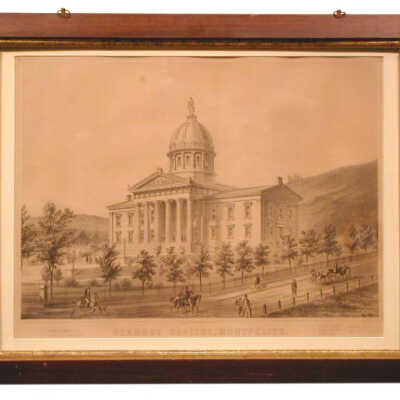
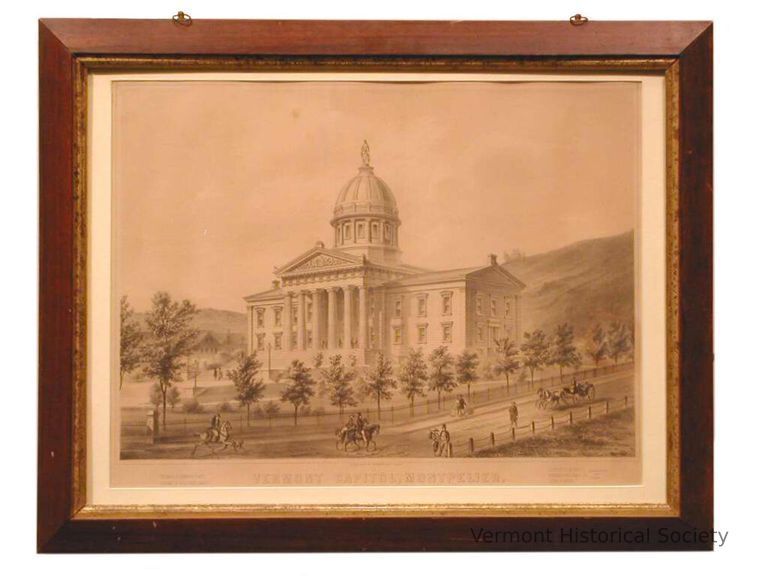
Vermont Capitol, Montpelier
Interpretative Labels
Label
Vermont Capitol, Montpelier, 1858-1859
J. H. Bufford's Lithographic and Publishing House (1857-1864)
Boston, MA
Print on paper
#A-178
This print was produced to celebrate the opening of the rebuilt Vermont State House in 1859. Drawn before the State House was completed, certain details do not match the finished building, including the entablature and statue.
Name/Title
Vermont Capitol, Montpelier
Lexicon
Description
Lithograph print showing the Vermont State House behind a wide, tree-lined road with several pedestrians and travelers on horseback or carriage. The building is a neoclassical building with a two-story, five-column colonnade and a tall cupola surmounted by a female figure.
Artwork Details
Subject
Vermont State House
Made/Created
Artist Information
Bufford, John Henry
Artist
Date made
1858-1859
Manufacturer
Bufford's Lithography
Dimensions
Dimension Description
Overall
Entry/Object ID
VHS-A-178
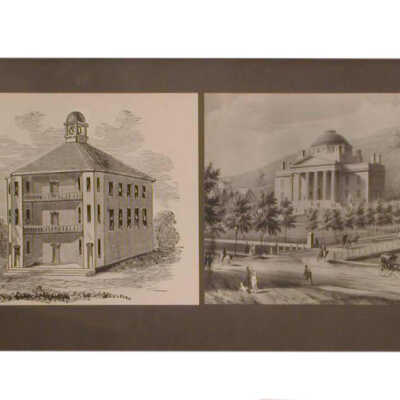

Vermont State House
Interpretative Labels
Label
First and Second State Houses
Modern prints
#A-130
Vermont's first State House was a wood-frame structure located roughly where the Supreme Court building now stands. The second State House, finished in 1838, was designed by architect Ammi Young and built of granite. This building burned in 1857. The current State House, completed in 1859, incorporates the portico of the second State House in its design.
Name/Title
Vermont State House
Lexicon
Description
Diptych consisting of copies of two prints of different iterations of the Vermont State House. The image on the left shows a three-story rectangular building with a peak roof, culminating in a cupola. The face of the building is framed by two bays extending up all three floor with balconies spanning between them. The image on the right shows the capitol from a slight distance. The building is neoclassical in design, with a two-story portico and squat, white cupola. It sits behind a tree-lined road with several pedestrians.
Acquisition
Accession
1971.58
Artwork Details
Subject
First and Second Vermont State Houses
Made/Created
Artist Information
Kilburne
Artist
Dimensions
Entry/Object ID
1971.58.1

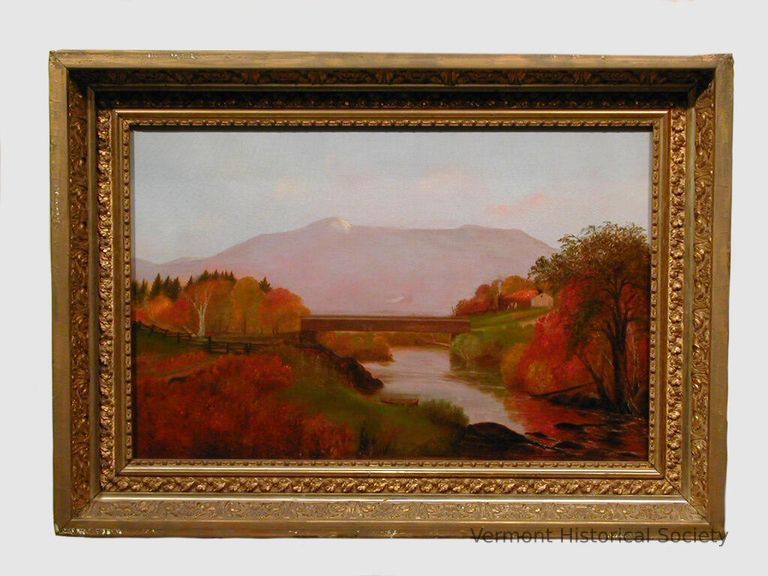
View at Underhill, Vermont
Interpretative Labels
Label
View at Underhill, Vermont, 1892
Charles L. Heyde (c. 1832-1892)
Burlington, VT
Oil on canvas
Museum Purchase, 1949.24.1
Charles Louis Heyde was one of the most prolific and celebrated Vermont artists of the 19th century. From 1856 until his death, he made Burlington his home, painting numerous scenes of Mount Mansfield, the Winooski River, and the High Bridge. He won a competition sponsored by the Vermont Historical Society in 1862 to redesign the Vermont coat-of-arms.
Heyde married Walt Whitman's sister Hannah, but the marriage was not happy. Alcoholism and dementia soon caused his business and personal life to fall apart. His later works, of which this is one, do not show nearly the quality of his output during his younger years. He died shortly after this painting was produced in the Vermont State Asylum in Waterbury.
Name/Title
View at Underhill, Vermont
Type of Painting
Description
Landscape showing the view from a bank next to river. The river is spanned by a covered bridge at the center of the composition, and flanked by autumn-colored trees. Mount Mansfield is seen in background. There is a house in a clearing on the right side of the river.
Acquisition
Accession
1949.24
Relationships
Related Places
Place
Mount Mansfield
Mountain
Underhill
Town
Chittenden County
County
Vermont
State/Province
United States of America
Country
North America
Dimensions
Context
Painted by Charles Louis Heyde in Burlington in 1892.
Lexicon
Artwork Details
Medium
Oil
Made/Created
Artist Information
Heyde, Charles Louis (1822-1892)
Artist
Date made
1892
Entry/Object ID
1949.24.1
Web Links and URLs